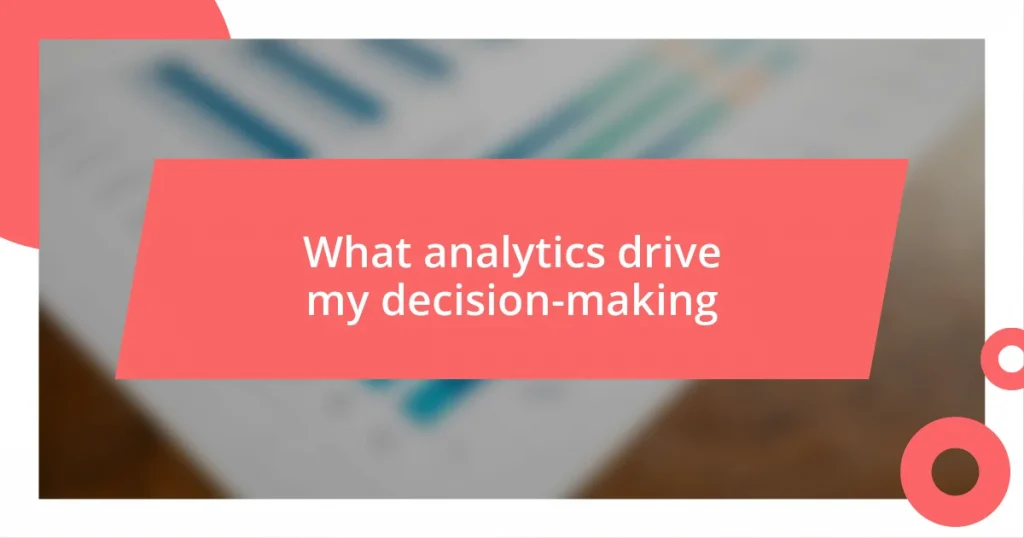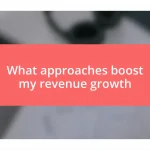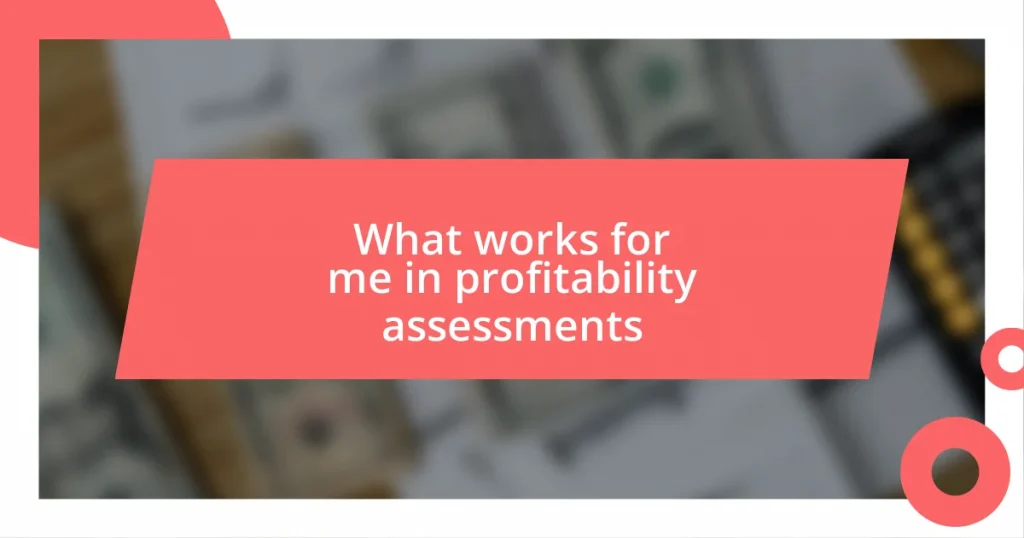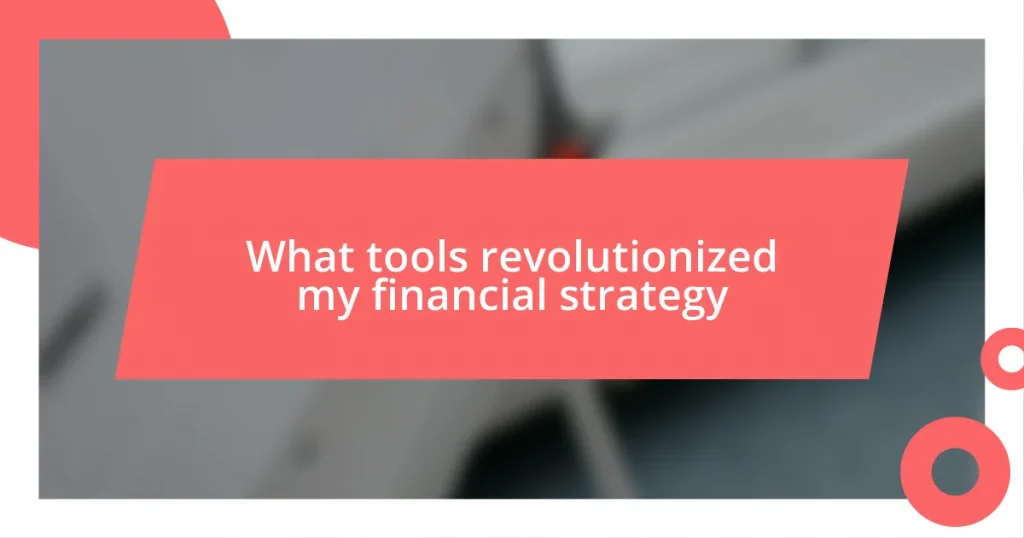Key takeaways:
- Effective decision-making analytics combines data insights with context for informed choices, enhancing team collaboration and innovation.
- There are three primary types of analytics: descriptive (historical insights), predictive (future forecasting), and prescriptive (action recommendations), each serving a unique purpose in decision-making.
- Continuous evaluation and feedback loops are essential for adapting strategies, fostering a culture of ownership, and driving sustained team motivation and creativity.

Understanding decision-making analytics
Decision-making analytics is all about using data to enhance choices. During my early career, I stumbled upon this approach when analyzing customer feedback. The insights I gained helped me prioritize user needs effectively, ultimately boosting satisfaction. Have you ever thought about how data can reshape your decisions?
When I first started leveraging analytics, it felt overwhelming. I recall poring over spreadsheets late into the night, wondering how numbers could lead to clarity amidst chaos. Gradually, the patterns emerged, and I realized that each data point told a story. Isn’t it fascinating how turning raw numbers into meaningful insights can make such a difference in decision-making?
Moreover, effective decision-making analytics doesn’t just rely on numbers; it requires understanding context. For instance, while metrics like sales trends are crucial, they don’t paint the entire picture without considering market conditions or consumer behavior. Have you ever made a decision based solely on data, only to find out later that the context changed everything? Embracing this holistic view is essential for making informed choices.

Types of analytics for decisions
Analytics plays a pivotal role in decision-making, and there are several distinct types that professionals commonly rely on. Descriptive analytics helps us understand past events by summarizing historical data. I still remember my first encounter with it while working on a marketing campaign. Analyzing previous sales data revealed key trends that guided future strategies, feeling like piecing together a puzzle. Have you ever noticed how looking back can sometimes shine a light on what lies ahead?
In contrast, predictive analytics is about forecasting future outcomes based on patterns. I had a project where we implemented predictive models to estimate user behavior on our platform. It was exhilarating to see how accurately we could anticipate customer actions, which drastically improved our targeting efforts. Isn’t it amazing how forecasting can arm you with knowledge before an event even occurs?
Finally, prescriptive analytics tells us what to do based on the data analysis. In one project, I utilized these recommendations to improve operational efficiency in our supply chain. The actionable insights provided a roadmap that transformed our processes. It’s like having a GPS for decision-making; without it, navigating through the maze of choices can be daunting.
| Type of Analytics | Description |
|---|---|
| Descriptive | Analyzes historical data to identify trends and patterns |
| Predictive | Forecasts future outcomes based on data patterns |
| Prescriptive | Offers recommendations for actions based on analysis |

Key metrics to measure performance
When measuring performance, identifying key metrics is essential. I vividly recall a time when I was tasked with evaluating the success of a campaign. The metrics I chose directly influenced our next steps, transforming raw data into strategic initiatives. Focusing on the right indicators makes all the difference — it’s like having a lens that brings clarity to your efforts.
Here’s a list of some crucial metrics that can guide your performance evaluations:
- Conversion Rate: Tracking the percentage of users who take desired actions helps assess the effectiveness of your strategies.
- Customer Retention Rate: Understanding how many customers return after their initial purchase can reveal satisfaction levels and loyalty.
- Return on Investment (ROI): This metric calculates the profitability of your investments, guiding budget allocation.
- Net Promoter Score (NPS): Gauging customer loyalty through their likelihood to recommend your product or service is invaluable for improving services.
- Customer Acquisition Cost (CAC): Analyzing the cost associated with acquiring a new customer helps in evaluating marketing efficiency and financial health.
Being precise about what to measure not only fuels informed decisions, but it also drives passion within your team. I’ve witnessed firsthand that when everybody aligns on relevant metrics, collaboration reaches new heights, paving the way for innovation and success.

Tools for gathering analytics
Gathering analytics effectively requires the right tools that cater to specific needs. In my experience, platforms like Google Analytics offer robust capabilities for tracking website performance and user behavior. I remember when I first set up an analytics dashboard; the wealth of insights it provided immediately transformed how I approached content strategy. Isn’t it fascinating how a single tool can unlock hidden patterns in your audience’s behavior?
On the other hand, I’ve found that integrating customer relationship management (CRM) tools, like HubSpot, greatly enhances data collection regarding customer interactions. By having a centralized system, I could better understand customer journeys. One instance stands out when I realized the importance of segmenting my audience; it helped me tailor my communications more effectively, significantly boosting engagement. It’s like discovering a treasure map that leads to more meaningful connections with your clientele.
Lastly, data visualization tools, such as Tableau, can dramatically enhance your ability to interpret and present data succinctly. I often rely on these tools to create visually engaging reports that simplify complex information. There was a time when a clear visualization helped me illustrate insights to stakeholders—which transformed a challenging discussion into a collaborative brainstorming session. Doesn’t it make a world of difference when you can turn numbers into compelling stories?

Interpreting data for insights
When it comes to interpreting data for insights, I find it essential to look beyond the numbers and delve into the story they tell. For example, I recall a project where our sales numbers were stagnant despite increased marketing efforts. At first, it was disheartening, but I decided to segment the data by customer demographics. The insights revealed patterns that pointed to a disconnect with our target audience. Isn’t it amazing how sometimes, the answers lie right before your eyes, waiting for you to ask the right questions?
I’ve also learned that context is key in data interpretation. I remember analyzing website traffic after launching a new campaign, only to discover spikes in traffic from unexpected sources. Instead of celebrating the numbers, I took a closer look at the referral paths. This led to a deeper understanding of how strategies resonate with different segments of our audience. By enriching my analysis with contextual clues, I could fine-tune our approach and ultimately drive better results. How often do we overlook the nuances that can truly shape our decisions?
Moreover, using a collaborative approach to data interpretation has proven invaluable. I recall a time when I gathered my team to review performance metrics, and what emerged was a mix of perspectives that enhanced our understanding of the data. Each team member brought unique insights, leading us to uncover correlations we might have missed individually. This experience emphasized to me the power of diverse viewpoints in driving innovation. Isn’t it fascinating how collective wisdom can turn data into actionable insights?

Implementing analytics in decision processes
Implementing analytics in decision processes has been a game changer in my professional journey. I vividly remember a time when my team decided to integrate a robust analytics framework into our decision-making workflows. Initially, there was some resistance, but as we started to share real-time data, collective insights began popping up everywhere. Suddenly, our discussions transformed, becoming richer and more grounded in evidence rather than gut feelings. Isn’t it enlightening when numbers start driving the narrative of your business?
As I guided my team through the process, I found that setting clear objectives for analytics usage was crucial. In one memorable strategy session, we identified specific KPIs to track our performance. Every time we reviewed those metrics, it felt like we were piecing together a puzzle. When we noticed a dip in user engagement, it prompted us to dig deeper into the data. This proactive approach not only allowed us to course-correct but also fostered a culture of data-driven decision-making. Isn’t it interesting how analytics can teach teams to not just react, but anticipate?
I’ve also discovered that the implementation of analytics requires a commitment to continuous learning. I recall a series of workshops we initiated to enhance our analytical skills across the board. The excitement in the room was palpable as team members began sharing their own findings and strategies. This collaborative environment made analytics feel less intimidating and more like an exciting adventure. How often do we miss out on the power of teamwork in harnessing data? Each of these moments reinforced my belief that analytics isn’t just a tool; it’s a catalyst for innovation and growth.

Continuous evaluation and adjustment strategies
Continuous evaluation is crucial in today’s data-driven landscape, and I’ve seen firsthand how it transforms outcomes. During one challenging project, we implemented a bi-weekly review of our metrics. Each session became a mini-classroom where we assessed what was working and what wasn’t. It was surprising how a simple routine empowered us to pivot quickly, leading to a more resilient strategy. Have you ever experienced that “aha” moment when consistent evaluation turns a struggle into success?
The adjustments we make based on evaluations are not just tactical; they often spark a deeper understanding of our core goals. I recall an instance where we adjusted our campaign mid-launch because the data didn’t align with our initial target audience. This realignment didn’t just affect the campaign’s performance; it also reignited my team’s passion and focus. Isn’t it remarkable how a shift in strategy can lead to renewed motivation and creativity?
I’ve learned that incorporating feedback loops is essential to refine our approaches continuously. One memorable feedback session I facilitated revealed that team members felt undervalued when their suggestions went unconsidered. By actively integrating their insights, we not only improved our processes but also fostered a sense of ownership within the team. This experience reinforced for me that continuous evaluation isn’t merely a mechanical exercise; it’s about cultivating an environment where everyone feels empowered to contribute. Wouldn’t you agree that the real magic happens when everyone is invested in the journey?















